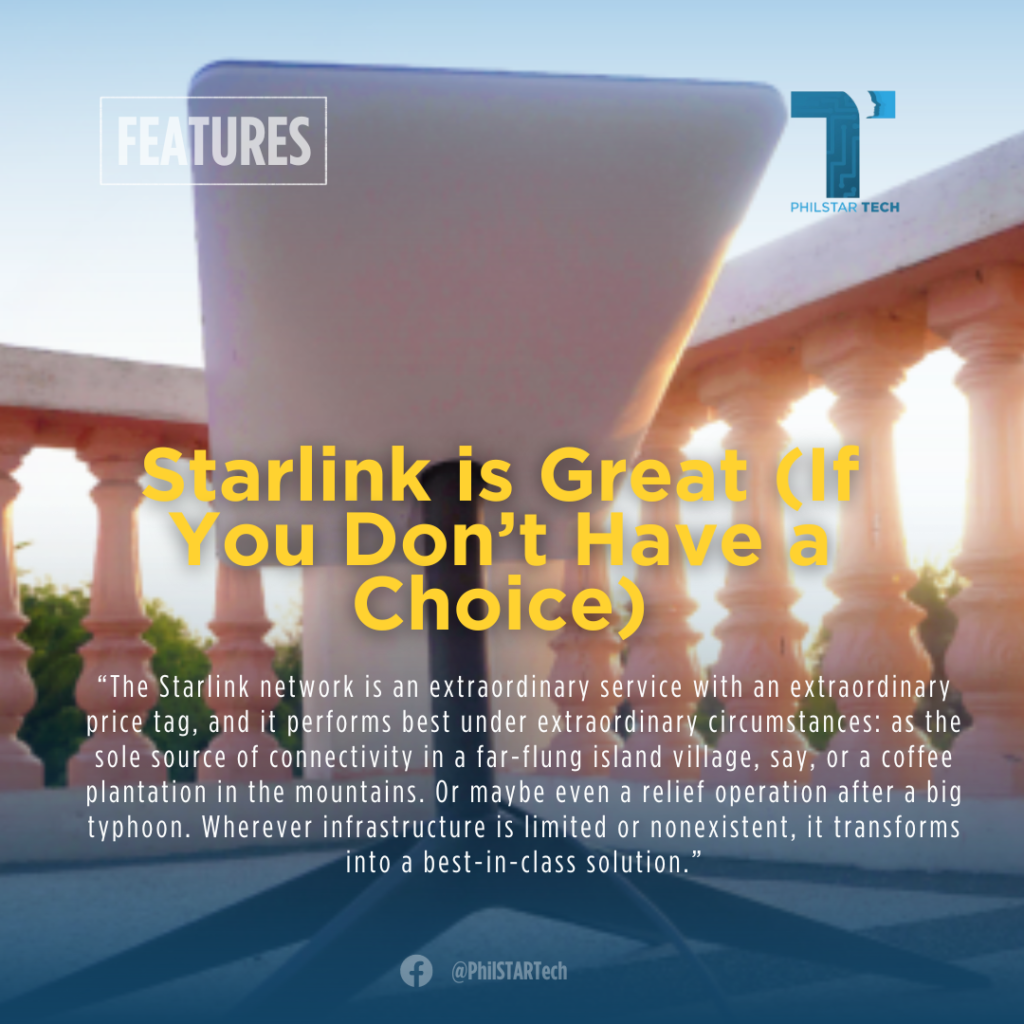By Luis Buenaventura
When Elon Musk first announced that Starlink was launching in the Philippines in 2022, an entire population of long-suffering Filipinos rejoiced. Many Pinoys experience a permanent kind of PTSD from our frustratingly unreliable ISPs, and to them, this sounded like a lifeline.
Starlink is an offshoot of SpaceX, Musk’s rocketry company. Every month, SpaceX launches around 60 Starlink satellites into space, and as of this writing, there are over 4,500 of them circling the planet in low-Earth orbit, delivering connectivity to customers in over 50 countries.
As one of the first users to receive their kit in late February, I got to test the service at both our city home in Taguig and our beach house in La Union. I ordered it directly through the official Starlink.com website, and received a small satellite dish, a wireless router, and a very long cable connecting the two devices.
The setup was straightforward, but not without its challenges: the single most important requirement is a clear view of the sky directly above your satellite dish. This can be difficult in the city, and basically impossible in Metro Manila condominiums. Even in our village in Fort Bonifacio, the only place I could get it working was on our third floor balcony.
With the dish running, the highest speed I got was just north of 100mbps. This was disappointing when you consider that our local ISPs offer plans that are 5 times faster at the same 2,700-peso price point. And let’s not forget that Starlink asks you to pay for the dish up-front, which at the time cost a steep 29,320 pesos. (They’ve since lowered that price to 19,999 pesos, much to my chagrin.)
The speedtest results at our provincial home were sadly similar. In fact, a few days into our Starlink experiments in La Union, I started to question what the point was. The speed was alright, but the fact that 500mbps fiber was also readily available made the pricier satellite service feel unjustifiable. Worse still, its 100ms ping times meant that any aspiring esports athletes in the household were going to feel deeply underserved.
And then, something interesting happened: the power went out.
It was one of those scheduled half-day outages that are typical of fast-growing provincial cities. In La Union, these municipality-wide blackouts are so frequent that, about a year ago, I splurged on a 2,000 watt-hour battery – a chunky beast that packs enough power to keep our devices running for days and recharges with a set of large solar panels.
It was when I connected Starlink to the battery that I finally got the answer I was looking for. Here was a wireless network solution that was completely untethered: my Internet connection was being beamed down from the sky to my receiver, which in turn was being powered by the Sun. If PLDT, Converge, and the La Union Electric Company were to all go down simultaneously, our little home wifi network would stay up.
It’s in these failure scenarios where SpaceX’s internet service starts to make sense. Granted, this “emergency” backup comes at a high price. Thankfully, their new “Mobile Regional” plan (3,300 pesos monthly) does allow you to pause your subscription whenever you don’t need it, something that I did eventually avail.
The Starlink network is an extraordinary service with an extraordinary price tag, and it performs best under extraordinary circumstances: as the sole source of connectivity in a far-flung island village, say, or a coffee plantation in the mountains. Or maybe even a relief operation after a big typhoon. Wherever infrastructure is limited or nonexistent, it transforms into a best-in-class solution.
Our beach house doesn’t really fall into any of those categories, of course. All I’m really planning for are garden-variety outages and blackouts, which at most can be costly inconveniences. But the next time the Internet or the power goes out in surftown, I’ll be ready to save the day with my little off-grid satellite setup. And until that glorious moment arrives, the Starlink will wait patiently on its balcony perch, aimed up at a sky full of unexpected possibilities.
#####


